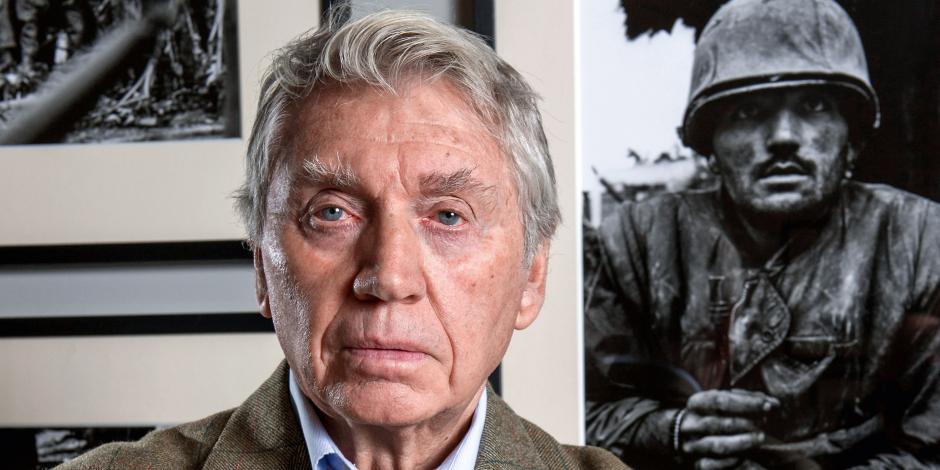When he was in his late 70s, Don McCullin was flown out by helicopter from a battlefield in Yemen. It was a surprising experience. Surprising not so much because of his age, but because of his profession. McCullin should probably have died years before – but here he was, returning home alive from yet another conflict.
He had just spent the day photographing people who’d been injured by landmines. Reflecting on that day, he later said in an interview: “Normally, people like me are in a nursing homePflegeheimnursing home, but here I am travelling back from a war zone. … Do you know why I go to these places? I think I belong there. … I would really like to sit in a corner and read newspapers, but if I do, I’ll go down the to go down the drain (ifml)vor die Hunde gehendrain. It’s the photographs that keep me going, physically and mentally.”
For more than 50 years, McCullin has been on the front lines of global conflicts. name itwas, wo auch immerName it, and he was there – Cyprus, Congo, Vietnam, Cambodia, Bangladesh, El Salvador, Northern Ireland, Lebanon, Israel – recording starving children, battle-hardenedkampferprobtbattle-hardened soldiers, to mourntrauernmourning fathers, mothers with cholera. He joined mercenarySöldnermercenaries in Congo, photographed the Ku Klux Klan in Mississippi, was wounded in Cambodia, was jailed in Uganda and was “wanted” by the government in Lebanon.
INFO TO GO
In November 2020, it was announced that Angelina Jolie would to direct sth.bei etw. Regie führendirect a biopicFilmbiografiebiopic about Don McCullin, with Tom Hardy in the starring roleHauptrollestarring role.
What made McCullin famous has been described as his ability to look steadily at the horrors people don’t want to look at, and then to turn those horrors into harrowingerschütternd, entsetzlichharrowing images they can’t look away from. Yet, he got into photojournalism by accident.
Understanding poverty and violence
Born in 1935, McCullin grew up poor. The family home was a dampfeuchtdamp, two-room flat in a basementUntergeschossbasement in London, unheated and with an outside toilet. His father died when McCullin was 13, so he left school and worked on a steam train, washing dishes in the dining car.
to call sb. upjmdn. einziehenCalled up for national serviceWehrdienstnational service, he spent time in Egypt during the Suez crisis, and then in Kenya and Cyprus, before returning to London. There, he began photographing friends from a local gang called “The Guv’nors”.
McCullin was persuaded to show the photographs to the picture editor of The Observer newspaper, who bought them immediately. The morning after the pictures were printed, McCullin’s phone started ringing with commissions for more work. The young photographer was excited but also terrified. He freely admits now that he knew little about photography and suffered from dyslexiaLegastheniedyslexia. However, his extraordinary eye for detail and determination would take him to the top of his profession.
McCullin talks about carrying the past “like an indelibleunauslöschbarindelible bloody tattoo. I’ve got more tattoos on me, psychologically, than David Beckham. … I think it was the very best possible way to begin my life, to prepare me for looking at other people’s tragic lives in the wars. I certainly understood poverty and violence.”
A golden era of photojournalism
The Observer bought McCullin’s first images in 1959, when he was 24. For the next two decades, war photography became his work – first, for The Observer and, later, from 1966, for The Sunday Times, England’s leading quality newspaper.
This was a golden era of photojournalism. Over the years, McCullin built a career as one of the world’s leading photographers of conflict, collecting awards and a few bullet wounds along the way.
In 1961, he won a British Press Award for his essay on the Berlin Wall. His first war was in Cyprus, where, in 1964, he reported on the conflict between Greek and Turkish communities. He won a World Press Photo Award for his images. McCullin recalls: “To be honest, I found it exciting. … It seems appallingbeängstigend, erschreckendappalling to say it when there was a war going on and people were being killed, but I found it all rather exhilaratinganregend, fesselndexhilarating.”
Looking at McCullin’s long career shows how he became increasingly aware of the moral ambiguityMehrdeutigkeitambiguities of his profession. We must be made aware of the horrors that people do to each other, and photography has the power to do this, but it takes a lot of adrenalin to achieve a powerful image.
Excitement and tragedy
“A photograph should shout at you and tell you something’s wrong, that you’re not living in the right kind of world, something that words can’t explain to you,” McCullin once answered when asked what makes a good photograph. This is an ability that shines through his work. The compassion with which he approached subjects made his photographs accessiblezugänglichaccessible and connected people to the reality of war.
McCullin’s photographs from Vietnam are particularly to acclaimhochschätzen, auszeichnenacclaimed. It was there, during the battle for the city of Hue in early 1968, that he took one of his most celebrated images. The photograph of a US marine in a moment of reflection is as intense a statement of the psychological impactAuswirkung(en)impact of war as many of his more graphic images of conflict and carnageMassaker, Blutbadcarnage.
People needed him to bring back important images: this was a challenge and a privilege. “For the first time in my life, I felt the focus was on my ability. Of course, morally, one can’t use the word excitement to describe wars, but at that stage, I hadn’t been injured. eventuallyschließlichEventually, though, I had to learn the difference between excitement and tragedy.”
The moment that changed everything was when he walked into a schoolhouse in 1969. The Nigerian state of Biafra was seeking independence, and civil war was to devastate sth./ sb.verheerende Auswirkungen auf etw./jmdn. habendevastating the civilian population. What McCullin found in the schoolhouse was 800 dying children.
“That was a monumental day of to sober upernüchternsobering up in my life, and it to hauntverfolgenhaunts me to this day,” he says. “These human beings were standing in front of me, thinking I was the great bringer of aid, and what did I show up with? Two Nikon cameras round my neck. It was a gut-wrenchingqualvollgut-wrenching, guilt-riddenschuldbeladenguilt-ridden experience to put that camera to my eye.”
McCullin has always pushed back at being labelled a “war photographer”. While he’s drawn to conflicts, his images of extreme poverty and homelessness are as powerful as anything he captured on battlefields. As he explains: “I went into international conflict and then I came back to social conflict.”
His images of poverty in the UK’s industrial heartland are distressingerschütternddistressing. He receives a lot of letters from people who want to be war photographers, and he tells them that there are many wars going on in our own cities. “If you want to be a war photographer, go out and help yourself. My best story wasn’t in a foreign war; my best story was the homeless story I did in the 1970s, in Aldgate, on the periphery of the great moneymaking part of this country, the the CityLondoner Banken- und FinanzviertelCity.”
Using black and white as a weapon
Today, McCullin is 85 and lives in a country house in Somerset, in south-west England. He has time for contemplationBetrachtung, Reflexioncontemplation, and to continue a series he’s been working on for over 20 years: photographing winter landscapes.
Like most of his other work, McCullin’s landscapes are black and white. “We use black and white as a weapon because it will shout and scream at you,” he says. “You won’t miss the black and white, but you could walk past a colour picture.”
This is a man who’s still trying to accept all he has been through. He’s described himself as being “contaminated by darkness, by the fearful things I’ve seen”. Elsewhere, he’s talked about the feeling of “carrying the suffering of the people you have photographed”.
Don McCullin’s suffering is contained in the 60,000 negatives carefully to file sth. awayetw. ablegen, archivierenfiled away in cabinets in his house, along with several thousand prints. But, he says, “I’ve felt that when I’m asleep upstairs at night, these ghosts get out of the filing cabinets and they contaminate the house.”
Neugierig auf mehr?
Dann nutzen Sie die Möglichkeit und stellen Sie sich Ihr optimales Abo ganz nach Ihren Wünschen zusammen.



